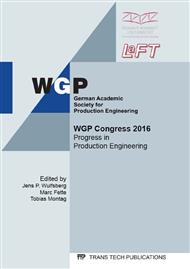[1]
W. Eversheim, Innovation Management for Technical Products, Springer Verlag, (2009).
Google Scholar
[2]
M. Tomizuka, Mechatronics: From the 20th to 21st century, Control Engineering Practice, 2002, pp.877-886.
DOI: 10.1016/s0967-0661(02)00016-3
Google Scholar
[3]
R. Cooper, Stage-Gate systems: A new tool for managing new products, Business Horizons, May-June 1990, pp.44-54.
DOI: 10.1016/0007-6813(90)90040-i
Google Scholar
[4]
G. Schuh, M. Cagna, K. Broichhausen, S. Rudof, K. Korthals, and B. Lüdtke, Der standardisierte Entwicklungsprozess (in German), Konstruktionspraxis 25, 2015, pp.20-22.
Google Scholar
[5]
N. Ruparelia, Software development lifecycle models, Software Engineering Notes, vol. 35, no. 3, May 2010, pp.8-13.
Google Scholar
[6]
H. Takeuchi, and I. Nonaka, The new new product development game, Harvard Business Review, vol. 64, no. 1, 1986, pp.137-146.
Google Scholar
[7]
K. Beck et al., Manifesto for agile software development, URL: http: /agilemanifesto. org/ [Checked on 2016. 03. 18].
Google Scholar
[8]
P. Smith, Flexible product development, Building agility for changing markets, (2007).
Google Scholar
[9]
G. Azizyan, M. Margarian, and M. Kajko-Mattson, Survey of agile tool usage and needs, Agile Conference, 2011, pp.29-38.
DOI: 10.1109/agile.2011.30
Google Scholar
[10]
D. Rico, H. Sayani, and S. Sone, The business value of agile software methods: Maximizing ROI with just-in-time processes and documentation, Fort Lauderdale, J. Ross Publishing, (2009).
Google Scholar
[11]
Y. Zhang, A. Bernard, R. K. Gupta, and R. Harik, Evaluating the design for additive manufacturing: A process planning perspective, Procedia CIRP, vol. 21, 2014, pp.144-150.
DOI: 10.1016/j.procir.2014.03.179
Google Scholar
[12]
P. Kettunen, Adopting key lessons from agile manufacturing to agile software product development: A comparative study, Technovation, vol. 29, 2009, pp.408-422.
DOI: 10.1016/j.technovation.2008.10.003
Google Scholar
[13]
K. Schwaber, Agile project management with SCRUM, Microsoft Press, (2004).
Google Scholar
[14]
D. Karlström and P. Runeson, Integration agile software development into stage-gate managed product development, Springer, 2006, pp.203-225.
DOI: 10.1007/s10664-006-6402-8
Google Scholar
[15]
B. W. Boehm, A spiral model of software development and enhancement, Computer 21 (5), DOI: 10. 1109/2. 59, pp.61-72.
Google Scholar
[16]
K. Beck, C. Andres, Extreme Programming Explained: Embrace Change, Boston, Addison-Wesley, (2005).
Google Scholar
[17]
R. Cooper, A. F. Sommer, A Promising New Approach and a New Research Opportunity, Journal of Product Innovation Management, DOI: 10. 1111/jpim. 12314, (2016).
Google Scholar
[18]
M. Stoica, M. Mircea, and B. Ghilic-Micu, Software development: Agile vs. traditional, Informativa Economică, vol. 17, no. 4, 2013, pp.64-76.
DOI: 10.12948/issn14531305/17.4.2013.06
Google Scholar
[19]
G. Schuh, S. Rudolf, F. Diels, Methodology for the evaluation and selection of the suitability of highly iterative product development methods for individual segments of an overall development project, Industrial Engineering and Engineering Management (IEEM), 2015, pp.661-665.
DOI: 10.1109/ieem.2015.7385730
Google Scholar
[20]
M. Baumgart, Modularisierung von Produkten im Anlagenbau (in German), Mainz, (2005).
Google Scholar
[21]
G. Pahl, W. Beitz, J. Feldhusen, and K-H. Grote, Engineering Design: A systematic approach, Springer, (2007).
Google Scholar
[22]
U. Lindemann, Festlegung der Gestalt (in German), Vorlesung Produktentwicklung und Konstruktion, 5. Vorlesung, Sommersemester 2007, TU München.
Google Scholar
[23]
G. Schuh, M. Lenders, and D. Bender, Szenariorobuste Produktarchitekturen (in German), in: J. Gausmeier, Vorausschau und Technologieplanung, 5. Symposium für Technologieplanung, Paderborn, Heinz Nixdorf Institut, 2009, pp.99-119.
Google Scholar
[24]
B. J. Jaworski and A. K. Kohli, Market orientation: Antecedents and consequences, Journal of Marketing, vol. 57, July 1993, pp.53-70.
DOI: 10.1177/002224299305700304
Google Scholar
[25]
Gebhardt, Generative Fertigungsverfahren: Additive Manufacturing und 3D Drucken für Prototyping – Tooling – Produktion (in German), Hanser, München, (2013).
DOI: 10.3139/9783446436527.fm
Google Scholar
[26]
Roland Berger Strategy Consultant, Additive manufacturing: A game changer for the manufacturing industry?, Munich, November 2013, URL: http: /www. rolandberger. de/media/ [Checked on 2015. 10. 07].
Google Scholar
[27]
B. Boehm, Get ready for agile methods, with care, IEEE Computer, vol. 35, 2002, pp.64-69.
DOI: 10.1109/2.976920
Google Scholar
[28]
D. V. Steward, The design structure system: A method for managing the design of complex systems, in IEEE Transactions on Engineering Management, vol. EM-28, 1981, pp.71-74.
DOI: 10.1109/tem.1981.6448589
Google Scholar
[29]
F. Diels, S. Rudolf, and G. Schuh, Highly iterative product development process for engineering projects, Progress in Production Engineering, WGP Congress, 2015, pp.532-539.
DOI: 10.4028/www.scientific.net/amm.794.532
Google Scholar


